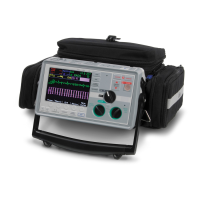9650-1210-01 Rev. R 5-1
SECTION 5
AUTOMATED EXTERNAL DEFIBRILLATOR
(AED) OPERATION
The AED unit has two modes of operation:
Semiautomatic or Manual. This section describes the
recommended method for analysis and defibrillation for
the AED unit in Semiautomatic mode. However, if your
local protocol requires a different procedure, follow that
protocol.
This section also describes how to switch the AED unit to
Manual mode (see “AED Manual Mode Operation” on
page 5-5).
The AED unit is capable of analyzing a patient’s ECG
rhythm in two different ways:
• The always active mode in the background of the
Semiautomatic mode (continuous analysis) when
MFE Pads or ECG cable and electrodes are in use.
• The user activated mode, initiated by pressing the
ANALYZE button.
User activated analysis can be performed only when:
• MFE Pads are connected.
• MFE Pads are firmly attached to the patient to reduce
any electrode noise or artifact.
• Selector switch is turned to ON.
In Semiautomatic mode, pressing the ANALYZE button
begins an analysis of the patient’s ECG in order to
determine if a shockable rhythm is present.
This analysis normally consists of three consecutive
3-second ECG rhythm analyses. If at least two of the
three analyses determine that the patient has a
shockable rhythm, the unit will automatically charge to
the preconfigured energy level and prompt the operator
to shock the patient. If two or more of the three 3-second
ECG analyses do not detect a shockable rhythm, the unit
will alert the operator that no shock is advised. A fourth
3-second interval will be analyzed if any of the first three
is noisy.
Following each shock, the continuous analysis function
resumes operation and displays and announces a
CHECK PATIENT prompt if a shockable rhythm is
detected. (Continuous analysis runs on a sliding
12 second window of ECG data, producing a result every
3 seconds. If three out of four 3-second segments are
shockable, the CHECK PATIENT message is issued.)
The CHECK PATIENT display and voice prompt are
inhibited for 70 seconds (subject to the length of the CPR
interval and whether or not CHECK PULSE is displayed)
following the completion of a user activated analysis or
discharge.
Note: The AED unit uses the Shock Conversion
Estimator function. See page 4-3 for detailed
information on this function.
MFE Pads are a defibrillation-protected Type BF patient connection.
WARNING
• Do not use the unit’s AED function on patients
under 8 years of age.
• The AutoPulse Plus is only intended for use on
adults 18 years of age or older. When using the
E Series and AutoPulse Plus as a system, this age
restriction applies to the E Series as well.
• Heart rate alarms are non-operational when the
AED unit is in semi-automatic mode.
WARNING
The rhythm analysis function may not reliably identify
ventricular fibrillation in the presence of an implantable
pacemaker. Inspection of the electrocardiogram and
clinical evidence of cardiopulmonary arrest should be
the basis for any treatment of patients with implantable
pacemakers.

